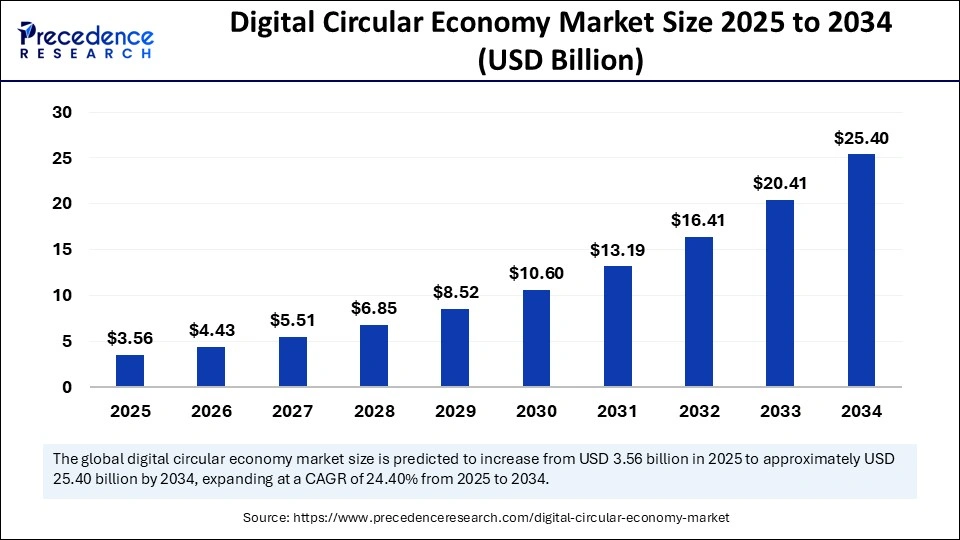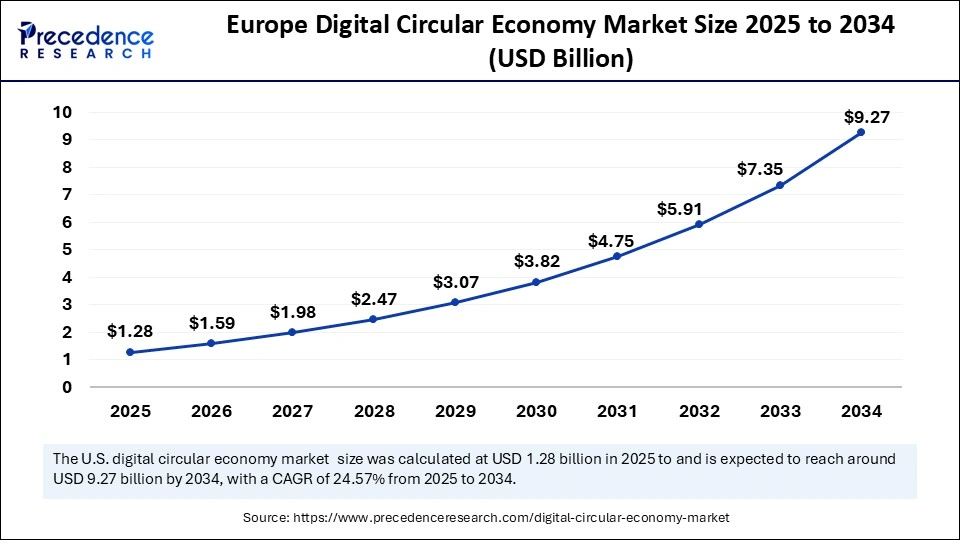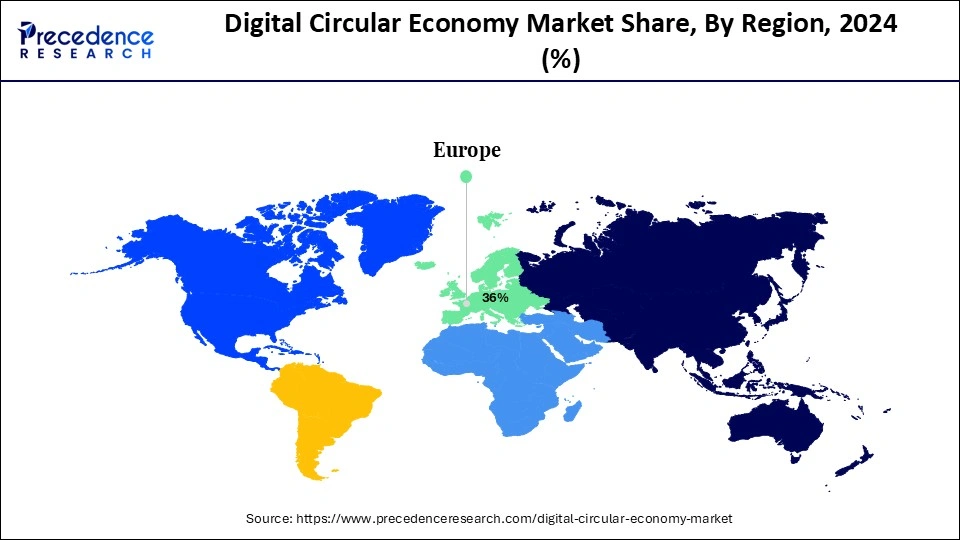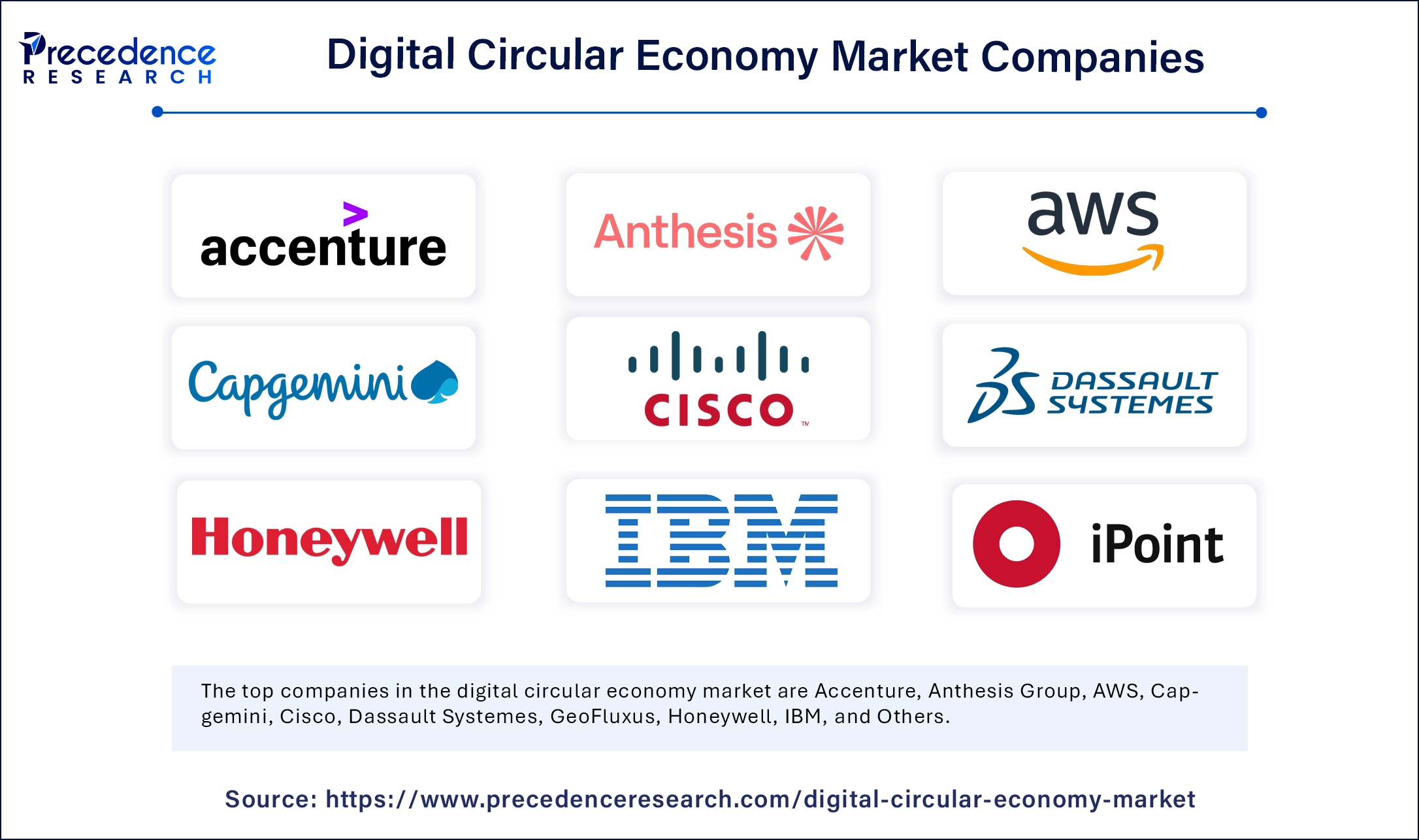List of Contents
Digital Circular Economy Market Size and Forecast 2025 to 2034
The global digital circular economy market size accounted for USD 2.86 billion in 2024 and is predicted to increase from USD 3.56 billion in 2025 to approximately USD 25.40 billion by 2034, expanding at a CAGR of 24.40% from 2025 to 2034. The growing awareness regarding the digital circular economy is the key factor driving market growth. Also, the growing accessibility of the educational infrastructure, coupled with the surge in the literate population across the globe, can fuel market growth further.

Digital Circular Economy Market Key Takeaways
- Europe dominated the digital circular economy market by holding more than 36% of market share in 2024.
- Asia Pacific is expected to grow at the fastest rate in the market over the forecast period.
By offering, the product lifecycle management (PLM) software segment dominated the market in 2024. - By offering, the supply chain management (SCM) software segment is expected to grow at the fastest rate over the forecast period.
- By technology, the IoT segment held the largest market share in 2024.
- By technology, the blockchain and distributed ledger technology (DLT) segment is anticipated to grow at the fastest rate over the forecast period.
- By application, the circular waste management and recycling segment led the global market in 2024.
- By application, the digital resale and reuse segment is projected to grow at the fastest rate over the forecast period.
Role of Artificial Intelligence (AI) in Improving Digital Circular Economy
Artificial Intelligence plays a transformative role in the digital circular economy market by improving product design and lifecycle management, streamlining resource usage, and enhancing waste management systems. It also allows organizations to make informed decisions, improve efficiency throughout the value chain, and forecast resource consumption. Furthermore, AI can facilitate the collection, refurbishment, and recycling of already-used materials, which makes the whole process cost-effective and efficient.
Europe Digital Circular Economy Market Size and Growth 2025 to 2034
The Europe digital circular economy market size was exhibited at USD 1.03 billion in 2024 and is projected to be worth around USD 9.27 billion by 2034, growing at a CAGR of 24.57% from 2025 to 2034.

Europe dominated the digital circular economy market in 2024. The dominance of the region can be attributed to the strong technological infrastructure coupled with the region's commitment to sustainability initiatives. Moreover, consumers in Europe exhibit a raised commitment and awareness of sustainable living, fueling the demand for services and products that align with circular economy principles. The region also boasts innovative digital capabilities, optimizing the integration of technologies like artificial intelligence and the Internet of Things (IoT).

U.K. Market Trends
In Europe, the Netherlands led the market owing to the country's emphasis on regulatory compliance and advancements, boosting the development of technologies, including IoT, AI, and blockchain, which improve efficiency and transparency in circular economy practices. Also, the strong partnerships between businesses and policymakers in the Netherlands are impacting positive market growth further.
- In December 2023, DS Smith, a British packaging manufacturer, unveiled an AWS-centric digital transformation to leverage data for effective business outcomes and a lower impact on the environment.
Asia Pacific is expected to grow at the fastest rate in the digital circular economy market over the forecast period. The growth of the region can be credited to the surge in government initiatives to enhance the overall disposable income. The emerging economies in the region, such as China and India, are showing good interest in fulfilling circular economy efficiency and strategies. Furthermore, the surge of digital platforms propelling resale, sharing, and reproduction optimizes the shift to a circular economy.
China Market Trends
In Asia Pacific, China dominated the digital circular economy market. The dominance of the country can be driven by the ongoing integration of technologies like IoT, blockchain, and AI into their supply chains to decrease waste, enhance transparency, and streamline resource use. These technologies also play a crucial role in tracking materials over their lifecycle.
Market Overview
The digital circular economy market consists of different interconnected processes, creating loops in the device's life cycle, which emphasizes preserving devices as important resources for a longer time. The value can be reduced over time, and regenerative processes such as recycling and refurbishment repurpose or restore them. These practices facilitate sustainability by recovering valuable materials and meeting new user demands, and reducing the overall environmental impact.
Digital Circular Economy Market Growth Factors
- The surge in awareness and concern regarding environmental sustainability is expected to boost the digital circular economy market growth further.
- Partnerships among businesses and the development of new business models can propel market growth shortly.
- The increasing shift towards digital platforms for product management will likely contribute to the market expansion soon.
Market Scope
| Report Coverage | Details |
| Market Size by 2034 | USD 25.40 Billion |
| Market Size in 2025 | USD 3.56 Billion |
| Market Size in 2024 | USD 2.86 Billion |
| Market Growth Rate from 2025 to 2034 | CAGR of 24.40% |
| Dominated Region | Europe |
| Fastest Growing Market | Asia Pacific |
| Base Year | 2024 |
| Forecast Period | 2025 to 2034 |
| Segments Covered | Offring, Technology, Application, and Region |
| Regions Covered | North America, Europe, Asia-Pacific, Latin America and Middle East & Africa |
Market Dynamics
Drivers
Expansion of the refurbished electronics market
The expansion of the electronics market is the major factor driving the growth of the digital circular economy market. Because sustainability has become a major component in consumer decisions, the need for pre-owned and high-quality electronics is growing. In addition, refurbished electronics provide budget-friendly options, which play an essential role in minimizing electronic waste, making them a primary choice for many consumers.
- In April 2025, UNECE and ISO launched a joint initiative on digital product passports to advance sustainability and the circular economy. Businesses, policymakers, and consumers alike are striving to make more informed decisions, driving progress toward a sustainable and circular economy.
Restraint
Lack of awareness among consumers
Many consumers are unaware of the potential benefits of circular economy models, such as environmental advantages and cost savings. Some people consider refurbished or recycled products as lower quality. Moreover, initial requirements for heavy investments in circular economy principles and digital technologies can pose a financial restraint for some businesses, hindering market growth.
Opportunity
Increasing shift towards sustainable practices
Major market players are experiencing a paradigm shift that decides how resources are manufactured, used, and recycled. This change is mainly facilitated by the integration of digital technologies with sustainable practices, which leads to the building of new processes, platforms, and strategies that focus on environmental health and economic efficiency. Furthermore, organizations are heavily investing in digital tools to improve traceability and reduce resource waste.
- In November 2024, Covestro and Deloitte jointly developed a monetization framework for the circular economy, developing and implementing business models in the circular economy. This can only be achieved through the interplay of consumers, producers, regulation, and technical solutions.
Offering Insight
The product lifecycle management (PLM) software segment dominated the digital circular economy market in 2024. The dominance of the segment can be attributed to its ability to integrate circular economy principles into production, product development, and end-of-life processes. Additionally, this segment serves as the backbone for tracking products over their lifecycle, from design to disposal. Market players majorly depend on these technologies to improve efficiency and sustainability.
- In August 2023, Fujitsu, Information Services International-Dentsu, Ltd., and DIGITAL PROCESS LTD. announced a collaboration in the area of engineering chains, starting to deliver product life cycle management (hereinafter PLM) systems for customers in the Japanese manufacturing industry.
The supply chain management (SCM) software segment is expected to grow at the fastest rate over the forecast period. The growth of the segment can be credited to the increasing demand for efficiency and automation, along with the raised adoption of innovative technologies. Also, organizations are rapidly seeking to optimize their operations, enhance efficiency, and decrease costs by adopting SCM software that offers real-time insights.
Technology Insight
The IoT segment held the largest digital circular economy market share in 2024. The dominance of the segment can be linked to the increasing use of IoT in the field, as it improves the whole recycling process by allowing smart tracking and sorting of materials. The IoT technology has a substantial ability to support circular design practices and green manufacturing, which drives the manufacturing of goods and services.
The blockchain and distributed ledger technology segment is anticipated to grow at the fastest rate over the forecast period. The growth of the segment can be driven by the ability of this technology to enable detailed tracking of materials, to ensure transparency over a product's lifecycle, from manufacturing to disposal. Moreover, companies such as Exxita Be Circular and Telefonica Tech are top of developing blockchain-based solutions.
Application Insight
The circular waste management and recycling segment led the global digital circular economy market in 2024. The dominance of the segment is due to the increasing need for resource conservation, sustainable waste disposal, and economic advantages offered by this segment. Furthermore, technological innovations in waste processing and recycling can positively impact segment growth. Governments in various countries are also implementing regulations and policies to promote the adoption of circular waste management.
The digital resale and reuse segment is projected to grow at the fastest rate over the forecast period. The growth of the segment is owing to the ongoing surge in digital e-commerce platforms for used items. Also, the establishment of this platform optimizes circular supply chain networks, supporting sustainability and waste reduction, and this also facilitates the value creation of used products by minimizing waste.
- In October 2024, Zara launched repair, resale, and donation services in the U.S. The Inditex-owned company is positioning the program as a step toward its goal of achieving carbon-neutral emissions by 2040. The repair service allows customers to request the repair of used Zara garments from any collection, per the release.
Digital Circular Economy Market Companies

- Accenture
- Anthesis Group
- AWS
- Capgemini
- Cisco
- Dassault Systemes
- GeoFluxus
- Honeywell
- IBM
- iPoint Systems
- Ingram Micro
- KPMG
- Landbell Group
Latest Announcement by Market Leaders
- In February 2025, Honeywell announced that its Board of Directors completed the comprehensive business portfolio evaluation launched a year ago by Chairman and CEO Vimal Kapur and intends to pursue a full separation of Automation and Aerospace Technologies. The planned separation, coupled with the previously announced plan to spin Advanced Materials, will result in three publicly listed industry leaders with distinct strategies and growth drivers.
Recent Developments
- In July 2024, Imperial launched the IceCube Lab, a state-of-the-art research facility dedicated to pioneering circular economy advancements. The lab will focus on developing innovative solutions to enhance sustainability, resource efficiency, and the integration of circular economy principles across industries.
- In May 2024, Flex, a global supply chain solutions company, announced the acquisition of FreeFlow, a leader in global secondary market asset disposition and digital circular economy solutions. This acquisition enhances Flex's capabilities in supporting circular economy practices through better management of product lifecycles and end-of-life asset recovery.
- In June 2023, Capgemini and AWS announced the launch of a new technology platform to extend the lifespan of aircraft parts at the International Paris Air Show (SIAE).
Segment Covered in the Report
By Offering
- Software
- Supply Chain Management (SCM) Software
- Sustainable Sourcing Software
- IoT and Sensor Integration Software
- Compliance and Reporting Software
- Product Lifecycle Management (PLM) Software
- Eco-Design and Prototyping Software
- Circular Manufacturing Software
- Sustainable Material Selection Software
- Blockchain And Traceability Software
- Product Traceability Software
- Sustainability Certification Software
- Supply Chain Transparency Software
- Circular Design and Prototyping Software
- Circular Design and Lifecycle Assessment Software
- Digital Prototyping and Simulation Software
- Sustainable Material Modeling Software
- 3D Printing Software
- 3D Printing Process Optimization Software
- Customized Product Design Software
- Sharing and Machining Software
- Resource Sharing Software
- Digital Marketplaces
- Product Life Extension Software
- Recovery and Recycling Software
- Other Software
- Supply Chain Management (SCM) Software
- Services
- Circular Economy Strategy Consulting Services
- Sustainability and Environmental Consulting Services
- Supply Chain Optimization Services
- Product-as-a-Service
- Recycling and Regulatory Compliance Services
- Other Services
By Technology
- Blockchain and Distributed Ledger Technology (DLT)
- Blockchain-Based Supply Chain
- Supply Chain Transparency
- Provenance Tracking
- Smart Contracts for Resource Transactions
- DLT-Enabled Asset Tokenization
- Tokenized Asset Management
- Digital Tokens for Circular Economy Products
- Token Exchange Platforms
- Blockchain-Based Supply Chain
- IoT
- IoT-Enabled Product Monitoring
- Remote Product Health Monitoring
- Condition-Based Maintenance
- Product Usage Analytics
- Smart Recycling Bins and Waste Management
- Smart Waste Collection Scheduling
- Recycling Sorting Automation
- IoT-Enhanced Recycling Centers
- IoT-Enabled Product Monitoring
- AI and ML
- Predictive Maintenance and Quality Control
- Predictive Equipment Maintenance
- Quality Assurance Algorithms
- Anomaly Detection
- Demand Forecasting
- Predictive Demand Models
- Inventory Optimization
- Production Planning
- Predictive Maintenance and Quality Control
- AR and VR
- AR For Design and Prototyping
- Augmented Product Design
- Virtual Prototyping
- Interactive Design Collaboration
- VR-Based Training
- Virtual Employee Training
- Safety Training Simulations
- Remote Expert Assistance
- Cloud Computing
- Cloud-Based Resource Planning
- Cloud-Based Circular Supply Chain Platforms
- Big Data Analytics
- Resource Utilization Analytics
- Circular Economy Performance Metrics
- Circular Economy Data Platforms
- Data Integration and Management
- Advanced Circular Analytics
- Other Technologies
By Application
- Supply Chain and Materials Tracking
- Product Lifecycle Traceability
- Circular Supply Chain Optimization
- Eco-Friendly Transportation Management
- Resource Optimization and Efficiency
- Resource Allocation and Utilization
- Energy and Water Management
- Waste Reduction and Recycling Efficiency
- Digital Resale and Reuse
- Online Resale Marketplaces
- Product Exchange Networks
- Circular Product Certification
- Reverse Logistics and Remanufacturing
- Collection and Sorting Services
- Remanufacturing and Refurbishment
- Waste-To-Resource Conversion
- Circular Economy Reporting and Compliance
- Circular Economy Performance Reporting
- Sustainability Certifications Management
- Regulatory Compliance
- Circular Waste Management and Recycling
- Waste Sorting and Recycling Apps
- Circular Waste-To-Energy Solutions
- Advanced Recycling Technologies
- Smart Material Selection and Testing
- Material Analytics and Selection
- Material Performance Testing
- Circular Materials R&D
- Other Applications
By Region
- NorthAmerica
- LatinAmerica
- Europe
- Asia-pacific
- Middle and East Africa
For inquiries regarding discounts, bulk purchases, or customization requests, please contact us at sales@precedenceresearch.com
Frequently Asked Questions
Ask For Sample
No cookie-cutter, only authentic analysis – take the 1st step to become a Precedence Research client